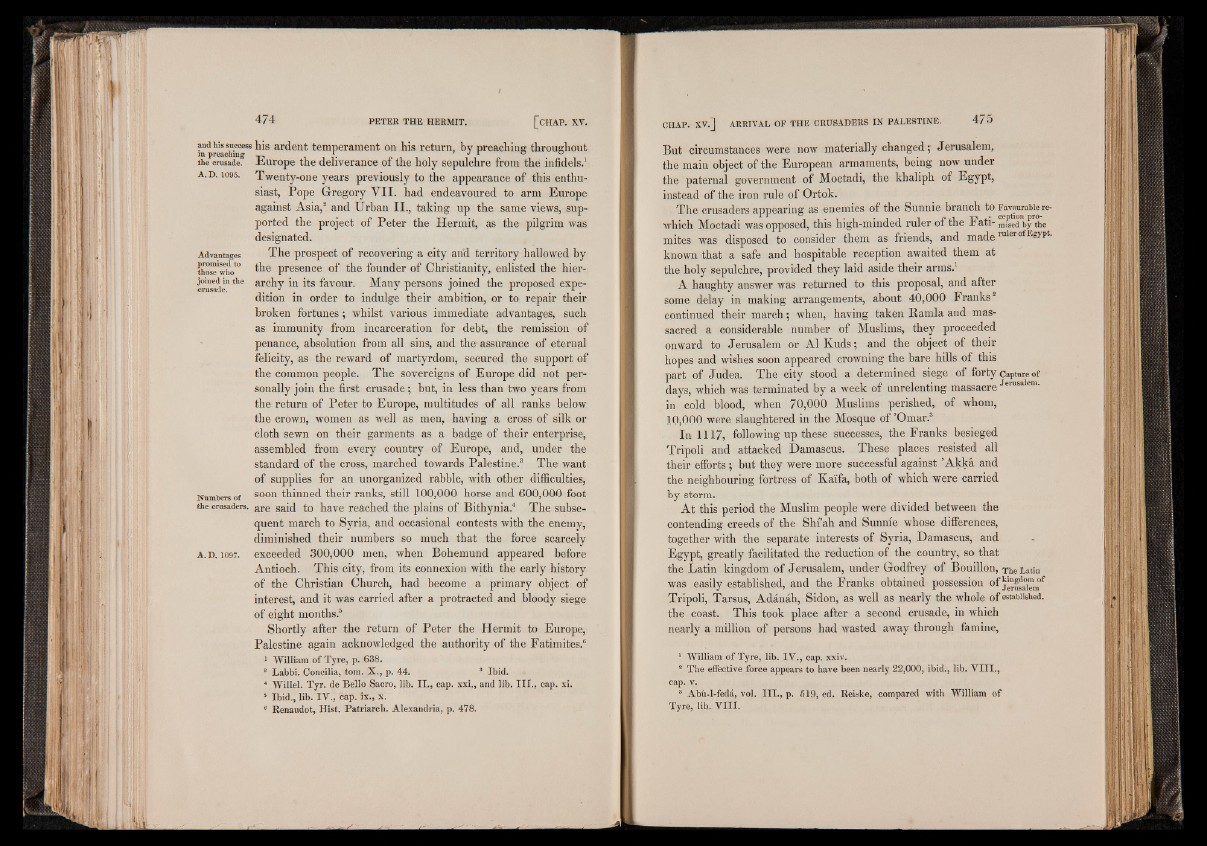
and his success his ardent temperament on his return, by preaching throughout in preaching \ J 1 ° 0
the crusade. .hurope the deliverance of the holy sepulchre from the infidels.1
a.d. 1095. Twenty-one years previously to the appearance of this enthusiast,
Pope Gregory VII. had endeavoured to arm Europe
against Asia,2 and Urban II., taking up the same views, supported
the project of Peter the Hermit, as the pilgrim was
designated.
Advantages The prospect of recovering a city and territory hallowed by
L T :tto the presence of the founder of Christianity, enlisted the hier-
imsadin *he archy *n its favour. Many persons joined the proposed expedition
in order to indulge their ambition, or to repair their
broken fortunes; whilst various immediate advantages, such
as immunity from incarceration for debt, the remission of
penance, absolution from all sins, and the assurance of eternal
felicity, as the reward of martyrdom, secured the support of
the common people. The sovereigns of Europe did not personally
join the first crusade; but, in less than two years from
the return of Peter to Europe, multitudes of all ranks below
the crown, women as well as men, having a cross of silk or
cloth sewn on their garments as a badge of their enterprise,
assembled from every country of Europe, and, under the
standard of the cross, marched towards Palestine.3 The want
of supplies for an unorganized rabble, with other difficulties,
Numbers of s00n thinned their ranks, still 100,000 horse and 600,000 foot
the crusaders. are said to have reached the plains of Bithynia.4 The subsequent
march to Syria, and occasional contests with the enemy,
diminished their numbers so much that the force scarcely
a . d. 1097. exceeded 300,000 men, when Bohemund appeared before
Antioch. This city, from its connexion with the early history
of the Christian Church, had become a primary object of
interest, and it was carried after a protracted and bloody siege
of eight months.6
Shortly after the return of Peter the Hermit to Europe,
Palestine again acknowledged the authority of the Fatimites.6
: William of Tyre, p. 638.
! Labbi. Concilia, tom. X ., p. 44. 8 Ibid.
4 Willel. Tyr. de Bello Sacro, lib. I I ., cap. xxi., and lib. I I I ., cap. xi.
5 Ibid., lib. IV ., cap. ix., x.
8 Renaudot, Hist. Patriarch. Alexandria, p. 478.
But circumstances were now materially changed; Jerusalem,
the main object of the European armaments, being now under
the paternal government of Moctadi, the khaliph of Egypt,
instead of the iron rule of Ortok.
The crusaders appearing as enemies of the Sunnie branch to Favourable re-
which Moctadi was opposed, this high-minded ruler of the Fati- mised by the
mites was disposed to consider them as friends, and madelulei ofEgypt'
known that a safe and hospitable reception awaited them at
the holy sepulchre, provided they laid aside their arms.1
A haughty answer was returned to this proposal, and after
some delay in making arrangements, about 40,000 Franks2
continued their march; when, having taken Ramla and massacred
a considerable number of Muslims, they proceeded
onward to Jerusalem or AlKuds; and the object of their
hopes and wishes soon appeared crowning the bare hills of this
part of Judea. The city stood a determined siege of forty capture of
days, which was terminated by a week of unrelenting massacre Jerasalem-
in cold blood, when 70,000 Muslims perished, of whom,
10,000 were slaughtered in the Mosque of ’Omar.3
In 1117, following up these successes, the Franks besieged
Tripoli and attacked Damascus. These places resisted all
their efforts; but they were more successful against ’Akka and
the neighbouring fortress of Kai'fa, both of which were carried
by storm.
At this period the Muslim people were divided between the
contending creeds of the Shi’ah and Sunnie whose differences,
together with the separate interests of Syria, Damascus, and
Egypt, greatly facilitated the reduction of the country, so that
the Latin kingdom of Jerusalem, under Godfrey of Bouillon, The Latin
was easily established, and the Franks obtained possession o f ] ^ “™mof
Tripoli, Tarsus, Adanah, Sidon, as well as nearly the whole of established,
the coast. This took place after a second crusade, in which
nearly a million of persons had wasted away through famine,
1 ’William of Tyre, lib. IV ., cap. xxiv.
8 The effective force appears to have been nearly 22,000, ibid., lib. V I I I .,
cap. v.
8 Abit-l-feda, vol. I I I ., p. 519, ed. Reiske, compared with William of
Tyre, lib. V I I I .